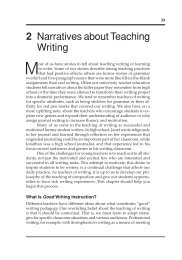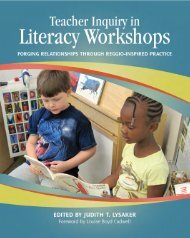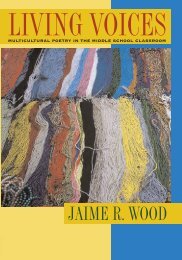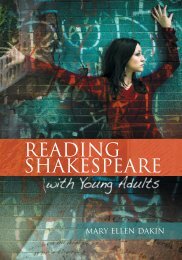Graphic novel Spread - National Council of Teachers of English
Graphic novel Spread - National Council of Teachers of English
Graphic novel Spread - National Council of Teachers of English
- No tags were found...
Create successful ePaper yourself
Turn your PDF publications into a flip-book with our unique Google optimized e-Paper software.
Introduction—Carving a Niche 13<br />
tial art seems destined to have an even more prominent place in the<br />
<strong>English</strong> language arts classroom.<br />
Lead-in to Case Study<br />
<strong>Graphic</strong> <strong>novel</strong>s are clearly gaining ground in public middle and high<br />
schools. However, texts such as Gorman’s are very recent. If students<br />
are to gain the full literacy benefits <strong>of</strong> the format, we need many more<br />
practical articles that describe educational experiments and classroom<br />
success stories from middle and high school teachers who have used<br />
graphic <strong>novel</strong>s. Most articles on graphic <strong>novel</strong>s and the classroom,<br />
whether research or applied practice in orientation, come from college<br />
pr<strong>of</strong>essors. Indeed, at the college level, the graphic <strong>novel</strong> enjoys more<br />
<strong>of</strong> the respect it deserves. What is needed is more evidence from researchers<br />
that graphic <strong>novel</strong>s improve literacy skills. These research<br />
studies would necessarily be conducted in concert with evidence from<br />
teachers who have used the format successfully, but these articles are<br />
also still relatively scarce. Although it is hoped that teachers might be<br />
convinced by this collection <strong>of</strong> essays and similar works to try comics<br />
or graphic <strong>novel</strong>s in the classroom, more needs to be written to be sufficiently<br />
compelling for the most conservative educators.<br />
The section that follows is a further attempt at driving home the<br />
practical side <strong>of</strong> teaching comics or graphic <strong>novel</strong>s in higher education,<br />
in summer programs, and, specifically, in North Carolina’s public school<br />
system. I present a personal case study <strong>of</strong> my own successes using the<br />
format to illustrate how comics or graphic <strong>novel</strong>s can be used to help<br />
reluctant or struggling readers as well as gifted readers. My efforts to<br />
teach Spiegelman’s Maus (1986; 1991) to an academically and intellectually<br />
gifted eighth-grade classroom are chronicled as a means <strong>of</strong> documenting<br />
the struggles the graphic form still must overcome to gain acceptance.<br />
I also explore other activities using sequential art narratives<br />
that my students and I enjoyed.<br />
A Personal Case Study<br />
I could provide you with numerous research articles, but, if you are like<br />
most practicing middle and high school teachers I know, nothing persuades<br />
you like real-life, down-to-earth experiences. That is another<br />
reason why the essays in this collection are so valuable: they represent<br />
the ideas and, <strong>of</strong>ten, the actual hands-on attempts <strong>of</strong> experienced, respected<br />
teachers in various levels <strong>of</strong> education. But let me take an
















